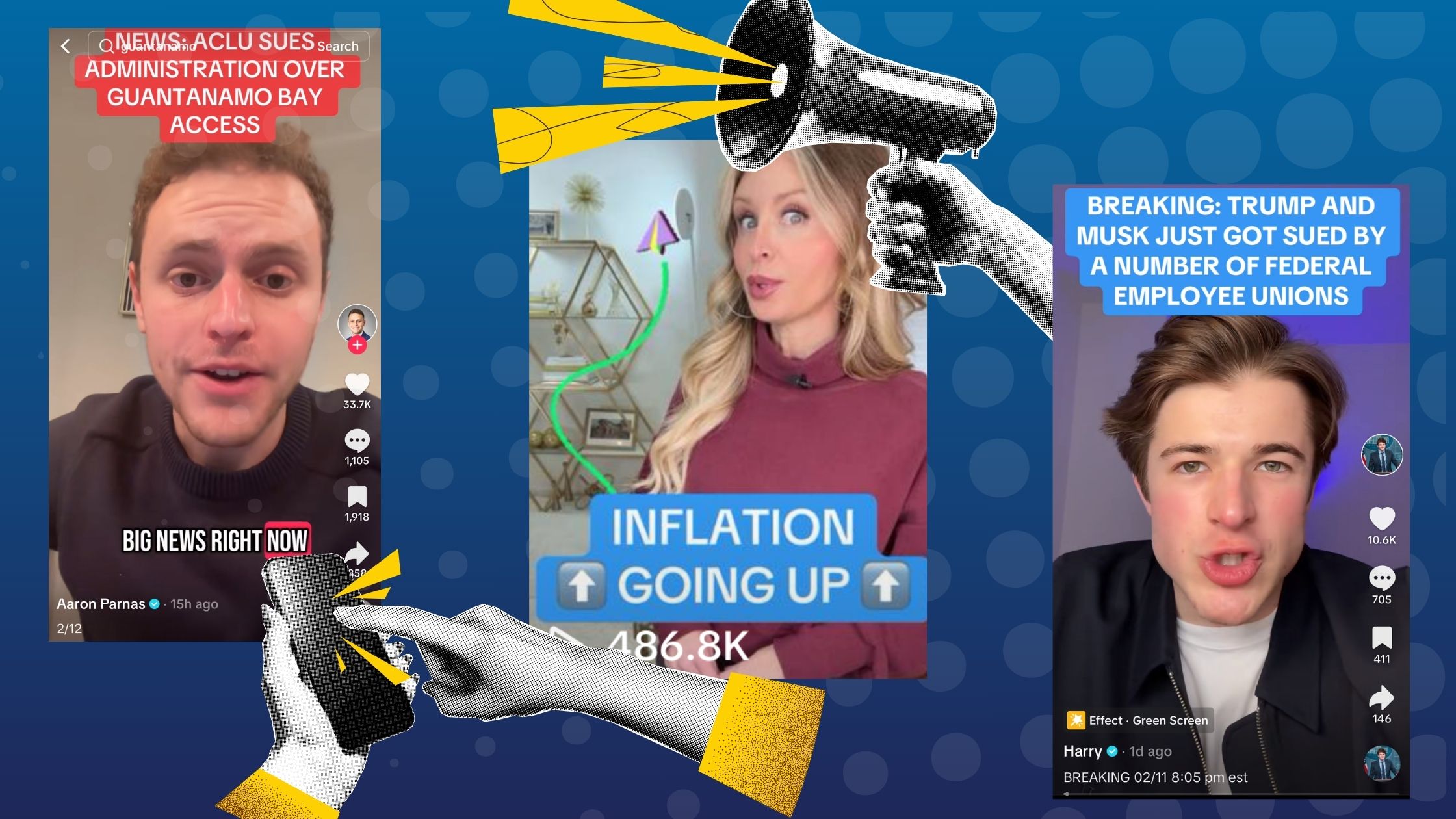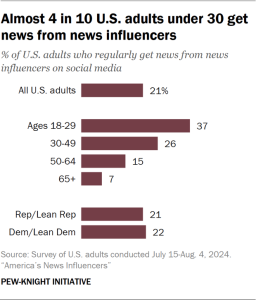News influencers are increasingly becoming a big source for news, specifically for the younger demographic. One in five Americans now get their news from influencers, according to a Pew Research study. For 18–29-year-olds, that number jumps to 37%. This coincides with rising mistrust of the media. A 2024 Gallup poll found 36% of adults have no trust at all in the media.
At her first briefing, Leavitt announced that “new media voices” such as those who create news-related content, specifically highlighting, “independent journalists, podcasters, social media influencers and content creators” will be welcomed into the White House briefing room, which was previously exclusive to only legacy media outlets and credentialed reporters. Since the announcement, the Trump administration has received over 11,000 applications for a ‘new media’ seat.
Now let’s rewind for a second. Back in summer, when Democrats and Republicans were both courting influencers, podcasters, and content creators, we wrote about the deluge of news influencers attending the Democratic National Convention (DNC).
A just-released Pew Research study which looked at how news influencers talked about Harris and Trump during the 2024 Presidential campaign, defined news influencers as “individuals who regularly post about current events and civic issues on social media and have at least 100,000 followers on any of Facebook, Instagram, TikTok, X (formerly Twitter) or YouTube. News influencers can be journalists who are or were affiliated with a news organization or independent content creators, but they must be people and not organizations.”
The term “influencer” seems synonymous with social media, however, we should note that when we talk about news influencers, that also encompasses bloggers, podcasters, Substack authors, and anyone establishing a following in this alternative media landscape.
Another key difference in this shift toward “new media” is how news influencers and traditional media operate. Unlike journalists, influencers aren’t bound by the same fact-checking processes or editorial oversight. According to a UNESCO survey, 62% of digital content creators don’t check their facts before sharing them. Additionally, many influencers expect compensation for their work, as content creation is their livelihood, whereas traditional journalists are paid by their media organizations and are generally prohibited from accepting any other payment for reporting due to ethical concerns.
While traditional journalists focus on objective reporting, news influencers often shape narratives and educate their followers through a more personal, opinion-driven approach. Because of this, organizations must be upfront when working with influencers—clarifying whether they are expected to remain neutral, take a stance, or have full editorial independence in how they report.
So, with news influencers cementing themselves as key players in media, nonprofit organizations are faced with a new challenge: Should they engage with them as they would traditional reporters? While legacy media outlets still hold influence, nonprofits and socially responsible businesses can think about incorporating influencers into their marketing strategies. Here are some questions and things to consider when determining if your organization should invest in, or include, influencers as part of your public relations strategy:
-
Is Your Organization Willing to Pay for Coverage or Offer Exclusive Access?
-
- Are you looking for earned media (unpaid, organic coverage) or paid partnerships (sponsorships)?
Unlike traditional product influencers, news influencers operate in a hybrid space between journalism and content creation, which impacts how partnerships work. Some news influencers operate like journalists, covering topics they find newsworthy without payment, while others may require compensation through partnerships or brand deals as that is their primary source of income. However, even in paid collaborations, pre-approval of content is not always guaranteed, as many influencers prioritize credibility with their audience and want to maintain their editorial independence. If an influencer is paid directly, they are legally required to disclose the partnership (e.g., using “#ad” or stating it’s sponsored), but this does not necessarily mean nonprofits can dictate the content. A good rule of thumb is to outline expectations upfront in a contract if monetary payment is involved, while access-based collaborations (e.g., event invites, exclusive interviews) should be treated like traditional media outreach, where content control is not expected. Since this space is still evolving, there is no universal rule so nonprofits have to look out for their best interest by carefully vetting influencers and setting clear guidelines while respecting their editorial freedom.
-
- If you have a smaller budget or no budget at all, can you offer them anything else of value (exclusive access, behind-the-scenes content, or invitations to events)?
-
Does Your Target Audience Get Their News from Influencers?
-
- Who are you trying to reach: donors, supporters, key stakeholders, legislators, or a mix?
-
- What is your audiences’ demographics?
-
-
- Age, location, gender, interests, etc. can all play a part in the decision of if your organization pursues influencers, and which ones.
- Also, considering your audience and their demographics, is social media the best place to reach them?
-
-
Does the Influencer Align with Your Mission & Values?
-
- Have they covered topics related to your cause before?
-
- Do they have a track record of credibility, or are they more opinion-driven? How strongly does this matter to your organization?
-
- Would partnering with them enhance or jeopardize your organization’s reputation?
-
-
- For example, a nonprofit focused on misinformation prevention or one that heavily relies on data should partner with influencers who are reputable for fact-checking, rather than those who thrive on hot takes and just sharing their opinion.
-
-
Are They Engaged with Their Audience?
-
- Does the influencer spark meaningful conversations, or do they primarily push their own views?
-
- Do their followers actively comment, share, and interact with their content?
-
-
- Engagement is more important than follower count – an influencer with 100,000 engaged followers is more valuable than one with 1 million passive followers.
-
-
What Type of Content Works Best for Your Message?
-
- Do you need short-form, quick-hitting news updates (TikTok, Instagram Reels, Threads)?
-
-
- This type of content is best for quick updates, breaking news, and reaching younger audiences who consume information in fast, engaging formats. It’s ideal for grabbing attention and sparking initial interest and awareness of your organization and cause.
-
-
- Would long-form storytelling (YouTube, podcasts, Substack) be better for deeper issue awareness?
-
- Long-form content is best for deep dives, in-depth analysis, and advocacy, catering to engaged audiences seeking deeper insights, explanations, and context. It’s ideal for those already interested in, or knowledgeable about, a topic or cause, as they are more likely to invest time in nuanced conversations. Can the influencer translate complex issues into digestible content and/or can you distill your organization’s pitch/message into suggested digestible content for them?
-
Is This a One-Time Opportunity or a Long-Term Relationship?
-
- Are you looking for a single feature, or do you want to build an ongoing relationship
-
-
- Long-term collaborations help create ambassadors who advocate for your cause beyond just sharing a one-off post.
-
The role of news influencers in today’s media landscape is no longer a passing trend—it’s a fundamental shift in how people consume news. As social platforms continue to shape public discourse, organizations must evolve and adapt. Whether your nonprofit or company chooses to engage with news influencers now or in the future, understanding their role in today’s news cycle is critical to staying relevant. The key is to approach influencer engagement with the same level of consideration and planning as you would with traditional press.
With those considerations in mind, are you thinking about incorporating news influencers into your PR or communications strategy? Let’s start the conversation about how Teak can help your organization navigate this evolving media landscape and build influencer partnerships that align with your mission.



